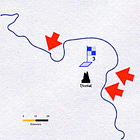The Hornet (I)
Tactical Lessons
On 20 December 1943, the recently formed Heavy Anti-Tank Battalion 519 went into action for the first time. In the two months that followed, it destroyed 290 Soviet tanks. In the same period, it lost six of its own vehicles. (Four of these were blown up by their crews because they could not be recovered after suffering mechanical breakdowns.)
On 28 February 1944, the commanding officer of Heavy Anti-Tank Battalion 519 committed to paper the lessons that he learned during the “shakedown cruise” of his unit.
Tactical Lessons
Undulating, compartmentalized terrain favors attacks by small armored units and the achievement of tactical objectives. However, it creates difficulties for massed armor attempting a breakthrough. The terrain limits the employment of massed tanks to areas that are only a few kilometers wide. Any attempt by tanks to break through is thus necessarily canalized. Mobile elements of the battalion and reserves should pay special attention to these defiles.
As always, the infantry wants to employ heavy anti-tank weapons in the immediate vicinity of the main line of resistance and during the first few days of the attachment [of the battalion to an infantry division] ordered the Hornets to remain in, and right behind, the main line of resistance. Orders for the correct employment of the battalion were only adopted after a long conversation at the headquarters of the Panzer Army.
The strength of the Hornet lies in the long range of its gun and its mobility. Few people understand these advantages. Therefore, the promising employment of the anti-tank companies is often prevented by unsuitable orders given ahead of time.
Explanation:
Instead of a mission, the company commander received an order to put his Hornets in particular places.
Hornets are ordered to remain in their firing positions in situations when they can only enter or leave them when it is dark.
Notwithstanding sufficient anti-tank defenses, Hornets are placed in widely separated firing positions, which dilutes their fighting power
Over and over again Hornets are employed in the manner of tanks and assault guns.
The Hornet company remains the weapon of decision [Schwerpunktwaffe] of the tactical leader and is, in a certain sense, the concentrated, mobile anti-tank fire brigade of the higher leadership.
The employment of a Hornet company rests on the following principles:
The company commander employs the company in accordance with his mission and his observations. He designates firing positions and assembly areas, and designates, in accordance with the situation, alternate firing positions that allow individual Hornets to keep watch over particular pieces of ground. In every situation, he must preserve his ability to employ his company as a mobile unit.
The use of small groups of Hornets for “free hunting” has worked well. Under the command of an especially accomplished leader, these Hornets are free from any connection to a particular place, but rather scour the countryside.
Employment of Hornets as assault guns or tanks should be avoided on principle, for the Russians often employ anti-tank weapons at the points of their attacks. The only two Hornets of the battalion that were destroyed by direct fire were lost when being used in that way.
For Further Reading:







“ The use of small groups of Hornets for “free hunting” has worked well.”
What must that have been like?
It cries out to be a video game.